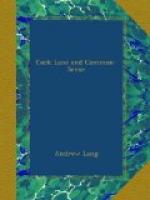Only one thing is certain about apparitions, namely this, that they do appear. They really are perceived. Now, as popular language confuses apparitions with ghosts, this statement sounds like an expression of the belief that ghosts appear. It has, of course, no such meaning. When Le Loyer, in 1586, boldly set out to found a ‘science of spectres,’ he carefully distinguished between his method, and the want of method observable in the telling of ghost stories. He began by drawing up long lists of apparitions which are not spectres, or ghosts, but the results of madness, malady, drink, fanaticism, illusions and so forth. It is true that Le Loyer, with all his deductions, left plenty of genuine spectres for the amusement of his readers. Like him we must be careful not to confound ‘apparitions,’ with ‘ghosts’.
When a fist, applied to the eye, makes us ‘see stars’; when a liver not in good working order makes us see muscae volitantes, or ‘spiders’; when alcohol produces ’the horrors,’—visions of threatening persons or animals,—when a lesion of the brain, or delirium, or a disease of the organs of sense causes visions, or when they occur to starved and enthusiastic ascetics, all these false perceptions are just as much ‘apparitions,’ as the view of a friend at a distance, beheld at the moment of his death, or as the unrecognised spectre seen in a haunted house.
In popular phrase, however, the two last kinds of apparitions are called ‘ghosts,’ or ‘wraiths,’ and the popular tendency is to think of these, and of these alone, when ‘apparitions’ are mentioned. On the other hand the tendency of common-sense is to rank the two last sorts of apparition, the wraith and ghost, with all the other kinds, which are undeniably caused by accident, by malady, mental or bodily, or by mere confusion and misapprehension, as when one, seeing a post in the moonlight, takes it for a ghost. Science, following a third path, would class all perceptions which ’have not the basis in fact that they seem to have’ as ‘hallucinations’. The stars seen after a blow on the eye are hallucinations,—there are no real stars in view,—and the friend, whose body seems to fill space before our sight when his body is really on a death-bed far away;— and again, the appearance of the living friend whom we see in the drawing-room while he is really in the smoking-room or in Timbuctoo,—are hallucinations also. The common-sense of the matter is stated by Aristotle. ’The reason of the hallucinations is that appearances present themselves, not only when the object of sense is itself in motion, but also when the sense is stirred, as it would be by the presence of the object’ (De Insomn., ii. 460, b, 23- 26).
The ghost in a haunted house is taken for a figure, say, of a monk, or of a monthly nurse, or what not, but no monthly nurse or monk is in the establishment. The ‘percept,’ is a ‘percept,’ for those who perceive it; the apparition is an apparition, for them, but the perception is hallucinatory.




